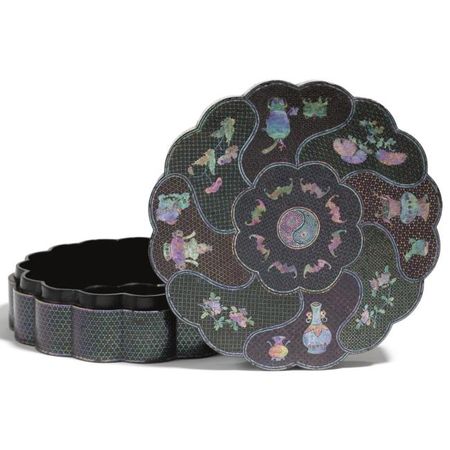A rare lacque burgaute box and cover. Qianlong period
A rare lacque burgaute box and cover. Qianlong period
of lobed form, the cover with a central floret panel containing a yin-yang motif surrounded by eight bats, with eight petal-form panels containing archaistic vases and scholars objects alternating with panels of flowers including chrysanthemum, camellia, and peony on a diaper ground, the interior of the cover and base each with a peony spray, Japanese wood box. 21.2cm., 8 3/8 in. Est. 20,000—30,000 GBP. Lot Sold 56,450 GBP NOTE: Large boxes made in the burgaute technique, known in Chinese as lo tian, whereby the inlaid design employs small shaped pieces of iridescent blue-green shells of the Haliotis and Nacre, also known as mother-of-pearl, are extremely rare. The workmanship of this box is exquisite, with the inlay detailed and fine, giving the overall design an almost print-like quality. No other similar example appears to be recorded, however, it is comparable with the famous burgaute decorated box, in the Palace Museum, Beijing, included in the Zhongguo meishu quanji. Gongyi meishu bian, vol. 8, Beijing, 1989, pl. 183, where the vessel is attributed to the Qianlong period. Another related flower-form box that serves as an inner-container for an elaborately carved cinnabar-lacquer box, is illustrated in Carved Lacquer in the Palace Museum, Beijing, 1985, pls. 298-299. See another floral inspired burgaute box decorated with several kinds of miniature diaper patterns, in the collection of the Los Angeles County Museum of Art, illustrated in George Kuwayama, Far Eastern Lacquer, Los Angeles, 1982, pl. 30, where the piece is described as a 'marvel of fine craftsmanship'. Further examples of vessels made in the same technique were included in the exhibition 2000 Years of Chinese Lacquer, Art Gallery, Chinese University of Hong Kong, Hong Kong, 1993, cat. no. 97, a small circular box finely inlaid with gold flakes and iridescent mother-of-pearl radiating from a centre formed by chrysanthemum-shaped petals; and cat. no. 98, a vase covered in several bands of different geometric patterns. Inlaid geometrical pattern can also be found on the sides of two three-tier boxes, from the collection of the Palace Museum, published in Zhongguo qiqi quanji, op. cit., pls. 171 and 172. The laborious lo tian process involves the cutting and inlay of small shell pieces which are then glued to the surface. The vessel is covered with a thick coat of lacquer which is ground and polished to reveal the decoration. As the shell-fragments come in different hues, the lacquer artisan had to build-up his design by carefully selecting the small fragments to produce a pattern that matched and was evenly brilliant. For the possible inspiration of the geometrical patterns see earlier, Yuan dynasty, wares, such as the tray and dish in the Asian Art Museum of San Francisco, published in Hai-Wai Yi-Chen. Chinese Art in Overseas Collections. Lacquerware, Taipei, 1987, pls. 66 and 67, as well as a large three-tiered Yuan period box, pl. 69, from the same collection. The form of the present box is reminiscent of smaller Song dynasty boxes made in silver; for example see a box in the Tokyo National Museum, illustrated in So Gen no bi, Tokyo, 2004, fig. 34, together with a similarly shaped qingbai box, fig. 35, both attributed to the Southern Song period. Sotheby's. Fine Chinese Ceramics & Works of Art. 13 May 09. London www.sothebys.com

/https%3A%2F%2Fprofilepics.canalblog.com%2Fprofilepics%2F1%2F0%2F100183.jpg)



/http%3A%2F%2Fstorage.canalblog.com%2F17%2F60%2F119589%2F65061244_p.jpg)
/http%3A%2F%2Fstorage.canalblog.com%2F01%2F26%2F577050%2F64298659_o.jpg)
/http%3A%2F%2Fstorage.canalblog.com%2F17%2F07%2F577050%2F63692116_o.jpg)
/http%3A%2F%2Fstorage.canalblog.com%2F24%2F46%2F577050%2F62252066_o.jpg)